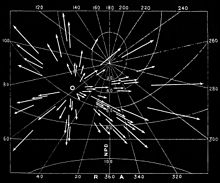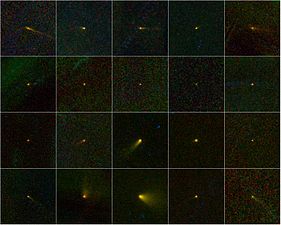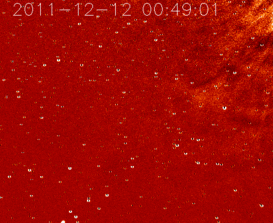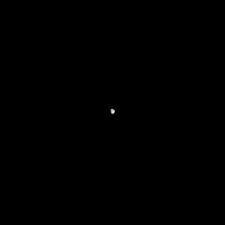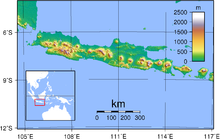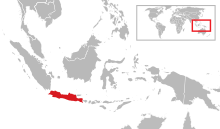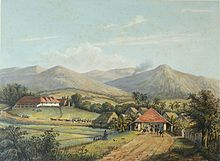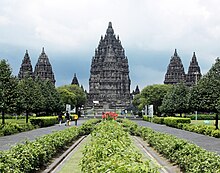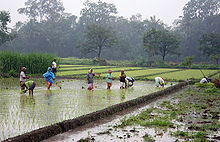From Wikipedia, the free encyclopedia
  |
 |
  |
Comets – nucleus, coma and tail (clockwise from top left)
· Comet 9P/Tempel collides with Deep Impact's impactor
· Comet 67P/Churyumov–Gerasimenko orbited by Rosetta
· Comet C/2011 W3 (Lovejoy) from orbit
· Comet 17P/Holmes and its blue ionized tail
· Comet 81P/Wild (Wild 2) visited by Stardust, 2004
· Comet 9P/Tempel collides with Deep Impact's impactor
· Comet 67P/Churyumov–Gerasimenko orbited by Rosetta
· Comet C/2011 W3 (Lovejoy) from orbit
· Comet 17P/Holmes and its blue ionized tail
· Comet 81P/Wild (Wild 2) visited by Stardust, 2004
A comet is an icy small Solar System body that, when passing close to the Sun, heats up and begins to outgas, displaying a visible atmosphere or coma, and sometimes also a tail. These phenomena are due to the effects of solar radiation and the solar wind upon the nucleus of the comet. Comet nuclei range from a few hundred metres to tens of kilometres across and are composed of loose collections of ice, dust, and small rocky particles. The coma and tail are much larger and, if sufficiently bright, may be seen from the Earth without the aid of a telescope. Comets have been observed and recorded since ancient times by many cultures.
Comets have a wide range of orbital periods, ranging from several years to several millions of years. Short-period comets originate in the Kuiper belt or its associated scattered disc, which lie beyond the orbit of Neptune. Longer-period comets are thought to originate in the Oort cloud, a spherical cloud of icy bodies extending from outside the Kuiper Belt to halfway to the next nearest star. Long-period comets are directed towards the Sun from the Oort cloud by gravitational perturbations caused by passing stars and the galactic tide. Hyperbolic comets may pass once through the inner Solar System before being flung out to interstellar space along hyperbolic trajectories.
Comets are distinguished from asteroids by the presence of an extended, gravitationally unbound atmosphere surrounding their central nucleus. This atmosphere has parts termed the coma (the central atmosphere immediately surrounding the nucleus) and the tail (a typically linear section consisting of dust or gas blown out from the coma by the Sun's light pressure or outstreaming solar wind plasma). However, extinct comets that have passed close to the Sun many times have lost nearly all of their volatile ices and dust and may come to resemble small asteroids.[1] Asteroids are thought to have a different origin from comets, having formed inside the orbit of Jupiter rather than in the outer Solar System.[2][3] The discovery of main-belt comets and active centaurs has blurred the distinction between asteroids and comets.
As of November 2014[update] there are 5,253 known comets,[4] a number which is steadily increasing. However, this represents only a tiny fraction of the total potential comet population, as the reservoir of comet-like bodies in the outer Solar System (in the Oort cloud) is estimated to be one trillion.[5][6] Roughly one comet per year is visible to the naked eye, though many of these are faint and unspectacular.[7] Particularly bright examples are called "Great Comets". Comets have been visited by unmanned probes such as the European Space Agency's Rosetta, which became the first ever to land a robotic spacecraft on a comet,[8] and NASA's Deep Impact, which blasted a crater on Comet Tempel 1 to study its interior.
Etymology
The word comet derives from the Old English cometa from the Latin comēta or comētēs. That, in turn, is a latinisation of the Greek κομήτης ("wearing long hair"), and the Oxford English Dictionary notes that the term (ἀστὴρ) κομήτης already meant "long-haired star, comet" in Greek. Κομήτης was derived from κομᾶν ("to wear the hair long"), which was itself derived from κόμη ("the hair of the head") and was used to mean "the tail of a comet".[9][10]The astronomical symbol for comets is (☄), consisting of a small disc with three hairlike extensions.[11]
Physical characteristics
Nucleus

Nucleus of Comet 103P/Hartley as imaged during a spacecraft flyby. The nucleus is about 2 km in length.
Comet Borrelly exhibits jets, but has no surface ice.
Comet Wild 2 exhibits jets on light side and dark side, stark relief, and is dry.
The solid, core structure of a comet is known as the nucleus. Cometary nuclei are composed of an amalgamation of rock, dust, water ice, and frozen gases such as carbon dioxide, carbon monoxide, methane, and ammonia.[12] As such, they are popularly described as "dirty snowballs" after Fred Whipple's model.[13] However, some comets may have a higher dust content, leading them to be called "icy dirtballs".[14] Research conducted in 2014 suggests that comets are like "deep fried ice cream", in that their surfaces are formed of dense crystalline ice mixed with organic compounds, while the interior ice is colder and less dense.[15]
The surface of the nucleus is generally dry, dusty or rocky, suggesting that the ices are hidden beneath a surface crust several metres thick. In addition to the gases already mentioned, the nuclei contain a variety of organic compounds, which may include methanol, hydrogen cyanide, formaldehyde, ethanol, and ethane and perhaps more complex molecules such as long-chain hydrocarbons and amino acids.[16][17] In 2009, it was confirmed that the amino acid glycine had been found in the comet dust recovered by NASA's Stardust mission.[18] In August 2011, a report, based on NASA studies of meteorites found on Earth, was published suggesting DNA and RNA components (adenine, guanine, and related organic molecules) may have been formed on asteroids and comets.[19][20]
The outer surfaces of cometary nuclei have a very low albedo, making them among the least reflective objects found in the Solar System. The Giotto space probe found that the nucleus of Halley's Comet reflects about four percent of the light that falls on it,[21] and Deep Space 1 discovered that Comet Borrelly's surface reflects less than 3.0% of the light that falls on it;[21] by comparison, asphalt reflects seven percent of the light that falls on it. The dark surface material of the nucleus may consist of complex organic compounds. Solar heating drives off lighter volatile compounds, leaving behind larger organic compounds that tend to be very dark, like tar or crude oil. The low reflectivity of cometary surfaces enables them to absorb the heat necessary to drive their outgassing processes.[22]
Comet nuclei with radii of up to 30 kilometres (19 mi) have been observed,[23] but ascertaining their exact size is difficult.[24] The nucleus of P/2007 R5 is probably only 100–200 metres in diameter.[25] A lack of smaller comets being detected despite the increased sensitivity of instruments has led some to suggest that there is a real lack of comets smaller than 100 metres (330 ft) across.[26] Known comets have been estimated to have an average density of 0.6 g/cm3.[27] Because of their low mass, comet nuclei do not become spherical under their own gravity and therefore have irregular shapes.[28]
Roughly six percent of the near-Earth asteroids are thought to be extinct nuclei of comets that no longer experience outgassing,[29] including 14827 Hypnos and 3552 Don Quixote.
| Name | Dimensions (km) |
Density (g/cm3) |
Mass (kg)[30] |
Refs |
|---|---|---|---|---|
| Halley's Comet | 15 × 8 × 8 | 0.6 | 3×1014 | [31][32] |
| Tempel 1 | 7.6 × 4.9 | 0.62 | 7.9×1013 | [33][27] |
| 19P/Borrelly | 8 × 4 × 4 | 0.3 | 2.0×1013 | [27] |
| 81P/Wild | 5.5 × 4.0 × 3.3 | 0.6 | 2.3×1013 | [34][27] |
| 67P/Churyumov–Gerasimenko | 4.1 × 3.3 × 1.8 | 0.47 | 1.0×1013 | [35][36] |
Coma
The streams of dust and gas thus released form a huge and extremely thin atmosphere around the comet called the "coma", and the force exerted on the coma by the Sun's radiation pressure and solar wind cause an enormous "tail" to form pointing away from the Sun.[38]
The coma is generally made of H2O and dust, with water making up to 90% of the volatiles that outflow from the nucleus when the comet is within 3 to 4 astronomical units (450,000,000 to 600,000,000 km; 280,000,000 to 370,000,000 mi) of the Sun.[39] The H2O parent molecule is destroyed primarily through photodissociation and to a much smaller extent photoionization, with the solar wind playing a minor role in the destruction of water compared to photochemistry.[39] Larger dust particles are left along the comet's orbital path whereas smaller particles are pushed away from the Sun into the comet's tail by light pressure.[40]
Although the solid nucleus of comets is generally less than 60 kilometres (37 mi) across, the coma may be thousands or millions of kilometres across, sometimes becoming larger than the Sun.[41] For example, about a month after an outburst in October 2007, comet 17P/Holmes briefly had a tenuous dust atmosphere larger than the Sun.[42] The Great Comet of 1811 also had a coma roughly the diameter of the Sun.[43] Even though the coma can become quite large, its size can actually decrease about the time it crosses the orbit of Mars around 1.5 astronomical units (220,000,000 km; 140,000,000 mi) from the Sun.[43] At this distance the solar wind becomes strong enough to blow the gas and dust away from the coma, enlarging the tail.[43] Ion tails have been observed to extend one astronomical unit (150 million km) or more.[42]
Both the coma and tail are illuminated by the Sun and may become visible when a comet passes through the inner Solar System, the dust reflecting Sunlight directly and the gases glowing from ionisation.[44] Most comets are too faint to be visible without the aid of a telescope, but a few each decade become bright enough to be visible to the naked eye.[45] Occasionally a comet may experience a huge and sudden outburst of gas and dust, during which the size of the coma greatly increases for a period of time. This happened in 2007 to Comet Holmes.[42]
In 1996, comets were found to emit X-rays.[46] This greatly surprised astronomers because X-ray emission is usually associated with very high-temperature bodies. The X-rays are generated by the interaction between comets and the solar wind: when highly charged solar wind ions fly through a cometary atmosphere, they collide with cometary atoms and molecules, "stealing" one or more electrons from the atom in a process called "charge exchange". This exchange or transfer of an electron to the solar wind ion is followed by its de-excitation into the ground state of the ion, leading to the emission of X-rays and far ultraviolet photons.[47]
Tails

Diagram of a comet showing the dust trail, the dust tail (or antitail) and the ion gas tail, which is formed by the solar wind flow.
Gas and snow jets on Comet Hartley 2
In the outer Solar System, comets remain frozen and inactive and are extremely difficult or impossible to detect from Earth due to their small size. Statistical detections of inactive comet nuclei in the Kuiper belt have been reported from observations by the Hubble Space Telescope[48][49] but these detections have been questioned.[50][51] As a comet approaches the inner Solar System, solar radiation causes the volatile materials within the comet to vaporize and stream out of the nucleus, carrying dust away with them.
The streams of dust and gas each form their own distinct tail, pointing in slightly different directions. The tail of dust is left behind in the comet's orbit in such a manner that it often forms a curved tail called the type II or dust tail.[44] At the same time, the ion or type I tail, made of gases, always points directly away from the Sun because this gas is more strongly affected by the solar wind than is dust, following magnetic field lines rather than an orbital trajectory.[52] On occasions - such as when the Earth passes through a comet's orbital plane, and we see the track of the comet edge-on, a tail pointing in the opposite direction to the ion and dust tails may be seen – the antitail.[53] (The dust tail of the comet prior to its rounding of the Sun is collinear with the dust tail post the rounding).[clarification needed]
The observation of antitails contributed significantly to the discovery of solar wind.[54] The ion tail is formed as a result of the ionisation by solar ultra-violet radiation of particles in the coma. Once the particles have been ionized, they attain a net positive electrical charge, which in turn gives rise to an "induced magnetosphere" around the comet. The comet and its induced magnetic field form an obstacle to outward flowing solar wind particles. Because the relative orbital speed of the comet and the solar wind is supersonic, a bow shock is formed upstream of the comet in the flow direction of the solar wind. In this bow shock, large concentrations of cometary ions (called "pick-up ions") congregate and act to "load" the solar magnetic field with plasma, such that the field lines "drape" around the comet forming the ion tail.[55]
If the ion tail loading is sufficient, then the magnetic field lines are squeezed together to the point where, at some distance along the ion tail, magnetic reconnection occurs. This leads to a "tail disconnection event".[55] This has been observed on a number of occasions, one notable event being recorded on April 20, 2007, when the ion tail of Encke's Comet was completely severed while the comet passed through a coronal mass ejection. This event was observed by the STEREO space probe.[56]
In 2013 ESA scientists reported that the ionosphere of the planet Venus streams outwards in a manner similar to the ion tail seen streaming from a comet under similar conditions."[57][58]
Jets
Uneven heating can cause newly generated gases to break out of a weak spot on the surface of comet's nucleus, like a geyser.[59] These streams of gas and dust can cause the nucleus to spin, and even split apart.[59] In 2010 it was revealed dry ice (frozen carbon dioxide) can power jets of material flowing out of a comet nucleus.[60] This is known because a spacecraft got so close that it could see where the jets were coming out, and then measure the infrared spectrum at that point which shows what some of the materials are.[61]Orbital characteristics
Most comets are small Solar System bodies with elongated elliptical orbits that take them close to the Sun for a part of their orbit and then out into the further reaches of the Solar System for the remainder.[62] Comets are often classified according to the length of their orbital periods: The longer the period the more elongated the ellipse.Short period
Periodic comets or short-period comets are generally defined as having orbital periods of less than 200 years.[63] They usually orbit more-or-less in the ecliptic plane in the same direction as the planets.[64] Their orbits typically take them out to the region of the outer planets (Jupiter and beyond) at aphelion; for example, the aphelion of Halley's Comet is a little beyond the orbit of Neptune. Comets whose aphelia are near a major planet's orbit are called its "family".[65] Such families are thought to arise from the planet capturing formerly long-period comets into shorter orbits.[66]At the shorter extreme, Encke's Comet has an orbit that does not reach the orbit of Jupiter, and is known as an Encke-type comet. Short-period comets with orbital periods shorter than 20 years and low inclinations (up to 30 degrees) are called "Jupiter-family comets".[67][68] Those like Halley, with orbital periods of between 20 and 200 years and inclinations extending from zero to more than 90 degrees, are called "Halley-type comets".[69][70] As of 2014[update], only 74 Halley-type comets have been observed, compared with 492 identified Jupiter-family comets.[71]
Recently discovered main-belt comets form a distinct class, orbiting in more circular orbits within the asteroid belt.[72]
Because their elliptical orbits frequently take them close to the giant planets, comets are subject to further gravitational perturbations.[73] Short-period comets have a tendency for their aphelia to coincide with a giant planet's semi-major axis, with the Jupiter-family comets being the largest group.[68] It is clear that comets coming in from the Oort cloud often have their orbits strongly influenced by the gravity of giant planets as a result of a close encounter. Jupiter is the source of the greatest perturbations, being more than twice as massive as all the other planets combined. These perturbations can deflect long-period comets into shorter orbital periods.[74][75]
Based on their orbital characteristics, short-period comets are thought to originate from the centaurs and the Kuiper belt/scattered disc[76] —a disk of objects in the trans-Neptunian region—whereas the source of long-period comets is thought to be the far more distant spherical Oort cloud (after the Dutch astronomer Jan Hendrik Oort who hypothesised its existence).[77] Vast swarms of comet-like bodies are believed to orbit the Sun in these distant regions in roughly circular orbits. Occasionally the gravitational influence of the outer planets (in the case of Kuiper belt objects) or nearby stars (in the case of Oort cloud objects) may throw one of these bodies into an elliptical orbit that takes it inwards toward the Sun to form a visible comet. Unlike the return of periodic comets, whose orbits have been established by previous observations, the appearance of new comets by this mechanism is unpredictable.[78]
Long period
Orbits of the Kohoutek Comet (red) and the Earth (blue), illustrating the high eccentricity of its orbit and its rapid motion when close to the Sun
Comets C/2012 F6 (Lemmon) (top) and C/2011 L4 (PANSTARRS) (bottom)
Long-period comets have highly eccentric orbits and periods ranging from 200 years to thousands of years.[79] An eccentricity greater than 1 when near perihelion does not necessarily mean that a comet will leave the Solar System.[80] For example, Comet McNaught had a heliocentric osculating eccentricity of 1.000019 near its perihelion passage epoch in January 2007 but is bound to the Sun with roughly a 92,600-year orbit because the eccentricity drops below 1 as it moves further from the Sun. The future orbit of a long-period comet is properly obtained when the osculating orbit is computed at an epoch after leaving the planetary region and is calculated with respect to the center of mass of the Solar System. By definition long-period comets remain gravitationally bound to the Sun; those comets that are ejected from the Solar System due to close passes by major planets are no longer properly considered as having "periods". The orbits of long-period comets take them far beyond the outer planets at aphelia, and the plane of their orbits need not lie near the ecliptic. Long-period comets such as Comet West and C/1999 F1 can have apoapsis distances of nearly 70,000 AU with orbital periods estimated around 6 million years.
| Hyperbolic comet discoveries |
|
|---|---|
| Year | # |
| 2014 | 9 |
| 2013 | 8 |
| 2012 | 10 |
| 2011 | 12 |
| 2010 | 4 |
| 2009 | 8 |
| 2008 | 7 |
| 2007 | 12 |
| Source: JPL, SSD[81] | |
Single-apparition or non-periodic comets are similar to long-period comets because they also have parabolic or slightly hyperbolic trajectories[79] when near perihelion in the inner Solar System. However, gravitational perturbations from giant planets cause their orbits to change. Single-apparition comets have a hyperbolic or parabolic osculating orbit which allows them to permanently exit the Solar System after a single pass of the Sun.[82] The Sun's Hill sphere has an unstable maximum boundary of 230,000 AU (1.1 parsecs (3.6 light-years)).[83] Only a few hundred comets have been seen to achieve a hyperbolic orbit (e > 1) when near perihelion[84] that using a heliocentric unperturbed two-body best-fit suggests they may escape the Solar System.
No comets with an eccentricity significantly greater than one have been observed,[84] so there are no confirmed observations of comets that are likely to have originated outside the Solar System. Comet C/1980 E1 had an orbital period of roughly 7.1 million years before the 1982 perihelion passage, but a 1980 encounter with Jupiter accelerated the comet giving it the largest eccentricity (1.057) of any known hyperbolic comet.[85] Comets not expected to return to the inner Solar System include C/1980 E1, C/2000 U5, C/2001 Q4 (NEAT), C/2009 R1, C/1956 R1, and C/2007 F1 (LONEOS).
Some authorities use the term "periodic comet" to refer to any comet with a periodic orbit (that is, all short-period comets plus all long-period comets),[86] whereas others use it to mean exclusively short-period comets.[79] Similarly, although the literal meaning of "non-periodic comet" is the same as "single-apparition comet", some use it to mean all comets that are not "periodic" in the second sense (that is, to also include all comets with a period greater than 200 years).
Early observations have revealed a few genuinely hyperbolic (i.e. non-periodic) trajectories, but no more than could be accounted for by perturbations from Jupiter. If comets pervaded interstellar space, they would be moving with velocities of the same order as the relative velocities of stars near the Sun (a few tens of km per second). If such objects entered the Solar System, they would have positive specific orbital energy and would be observed to have genuinely hyperbolic trajectories. A rough calculation shows that there might be four hyperbolic comets per century within Jupiter's orbit, give or take one and perhaps two orders of magnitude.[87]
Oort cloud and Hills cloud
Exocomets
Exocomets beyond our Solar System have also been detected and may be common in the Milky Way Galaxy.[93] The first exocomet system detected was around Beta Pictoris, a very young type A V star, in 1987.[94][95] A total of 10 such exocomet systems have been identified as of 2013[update], using the absorption spectrum caused by the large clouds of gas emitted by comets when passing close to their star.[93][94]Effects of comets
Connection to meteor showers
As a result of outgassing, comets leave in their wake a trail of solid debris too large to be swept away by radiation pressure and the solar wind.[96] If the comet's path crosses the path the Earth follows in orbit around the Sun, then at that point there are likely to be meteor showers as Earth passes through the trail of debris. The Perseid meteor shower, for example, occurs every year between August 9 and August 13, when Earth passes through the orbit of Comet Swift–Tuttle.[97] Halley's Comet is the source of the Orionid shower in October.[97]
Comets and impact on life
Many comets and asteroids collided into Earth in its early stages. Many scientists believe that comets bombarding the young Earth about 4 billion years ago brought the vast quantities of water that now fill the Earth's oceans, or at least a significant portion of it. Other researchers have cast doubt on this theory.[98] The detection of organic molecules, including polycyclic aromatic hydrocarbons,[15] in significant quantities in comets has led some to speculate that comets or meteorites may have brought the precursors of life—or even life itself—to Earth.[99] In 2013 it was suggested that impacts between rocky and icy surfaces, such as comets, had the potential to create the amino acids that make up proteins through shock synthesis.[100]It is suspected that comet impacts have, over long timescales, also delivered significant quantities of water to the Earth's Moon, some of which may have survived as lunar ice.[101] Comet and meteoroid impacts are also believed responsible for the existence of tektites and australites.[102]
Fate of comets
Departure (ejection) from Solar System
If a comet is traveling fast enough, it may leave the Solar System; such is the case for hyperbolic comets. To date, comets are only known to be ejected by interacting with another object in the Solar System, such as Jupiter.[103] An example of this is thought to be Comet C/1980 E1, which was shifted from a predicted orbit of 7.1 million years around the Sun, to a hyperbolic trajectory, after a 1980 encounter with the planet Jupiter.[104]Volatiles exhausted
Jupiter-family comets and long-period comets appear to follow very different fading laws. The JFCs are active over a lifetime of about 10,000 years or ~1,000 orbits whereas long-period comets fade much faster. Only 10% of the long-period comets survive more than 50 passages to small perihelion and only 1% of them survive more than 2,000 passages.[29] Eventually most of the volatile material contained in a comet nucleus evaporates away, and the comet becomes a small, dark, inert lump of rock or rubble that can resemble an asteroid.[105] Some asteroids in elliptical orbits are now identified as extinct comets.[106] Roughly six percent of the near-Earth asteroids are thought to be extinct nuclei of comets that no longer emit gas.[29]Breakup and collisions
The nucleus of some comets may be fragile, a conclusion supported by the observation of comets splitting apart.[107] A significant cometary disruption was that of Comet Shoemaker–Levy 9, which was discovered in 1993. A close encounter in July 1992 had broken it into pieces, and over a period of six days in July 1994, these pieces fell into Jupiter's atmosphere—the first time astronomers had observed a collision between two objects in the Solar System.[108][109] Other splitting comets include 3D/Biela in 1846 and 73P/Schwassmann–Wachmann from 1995 to 2006.[110] Greek historian Ephorus reported that a comet split apart as far back as the winter of 372–373 BC.[111] Comets are suspected of splitting due to thermal stress, internal gas pressure, or impact.[112]Comets 42P/Neujmin and 53P/Van Biesbroeck appear to be fragments of a parent comet. Numerical integrations have shown that both comets had a rather close approach to Jupiter in January 1850, and that, before 1850, the two orbits were nearly identical.[113]
Some comets have been observed to break up during their perihelion passage, including great comets West and Ikeya–Seki. Biela's Comet was one significant example, when it broke into two pieces during its passage through the perihelion in 1846. These two comets were seen separately in 1852, but never again afterward. Instead, spectacular meteor showers were seen in 1872 and 1885 when the comet should have been visible. A lesser meteor shower, the Andromedids, occurs annually in November, and it is caused when the Earth crosses the orbit of Biela's Comet.[114]
Some comets meet a more spectacular end – either falling into the Sun[115] or smashing into a planet or other body. Collisions between comets and planets or moons were common in the early Solar System: some of the many craters on the Moon, for example, may have been caused by comets. A recent collision of a comet with a planet occurred in July 1994 when Comet Shoemaker–Levy 9 broke up into pieces and collided with Jupiter.[116]
Nomenclature

Halley's Comet (photo,1910)
The names given to comets have followed several different conventions over the past two centuries. Prior to the early 20th century, most comets were simply referred to by the year when they appeared, sometimes with additional adjectives for particularly bright comets; thus, the "Great Comet of 1680", the "Great Comet of 1882", and the "Great January comet of 1910".
After Edmund Halley demonstrated that the comets of 1531, 1607, and 1682 were the same body and successfully predicted its return in 1759 by calculating its orbit, that comet became known as Halley's Comet.[118] Similarly, the second and third known periodic comets, Encke's Comet[119] and Biela's Comet,[120] were named after the astronomers who calculated their orbits rather than their original discoverers. Later, periodic comets were usually named after their discoverers, but comets that had appeared only once continued to be referred to by the year of their apparition.[121]
In the early 20th century, the convention of naming comets after their discoverers became common, and this remains so today. A comet can be named after its discoverers, or an instrument or program that helped to find it.[121]
History of study
Early observations and thought
From ancient sources, such as Chinese oracle bones, it is known that their appearances have been noticed by humans for millennia.[122] Until the sixteenth century, comets were usually considered bad omens of deaths of kings or noble men, or coming catastrophes, or even interpreted as attacks by heavenly beings against terrestrial inhabitants.[123][124]
Aristotle believed that comets were atmospheric phenomena, due to the fact that they could appear outside of the Zodiac and vary in brightness over the course of a few days.[125] Pliny the Elder believed that comets were connected with political unrest and death.[126]
In the 16th century Tycho Brahe demonstrated that comets must exist outside the Earth's atmosphere by measuring the parallax of the Great Comet of 1577 from observations collected by geographically separated observers. Within the precision of the measurements, this implied the comet must be at least four times more distant than from the Earth to the Moon.[127][128]
Orbital studies
Isaac Newton, in his Principia Mathematica of 1687, proved that an object moving under the influence of his inverse square law of universal gravitation must trace out an orbit shaped like one of the conic sections, and he demonstrated how to fit a comet's path through the sky to a parabolic orbit, using the comet of 1680 as an example.[129]In 1705, Edmond Halley (1656–1742) applied Newton's method to twenty-three cometary apparitions that had occurred between 1337 and 1698. He noted that three of these, the comets of 1531, 1607, and 1682, had very similar orbital elements, and he was further able to account for the slight differences in their orbits in terms of gravitational perturbation by Jupiter and Saturn. Confident that these three apparitions had been three appearances of the same comet, he predicted that it would appear again in 1758–9.[130] Halley's predicted return date was later refined by a team of three French mathematicians: Alexis Clairaut, Joseph Lalande, and Nicole-Reine Lepaute, who predicted the date of the comet's 1759 perihelion to within one month's accuracy.[131] When the comet returned as predicted, it became known as Halley's Comet (with the latter-day designation of 1P/Halley). It will next appear in 2061.[132]
Studies of physical characteristics
Newton suspected that comets were the origin of the life-supporting component of air.[134]
As early as the 18th century, some scientists had made correct hypotheses as to comets' physical composition. In 1755, Immanuel Kant hypothesized that comets are composed of some volatile substance, whose vaporization gives rise to their brilliant displays near perihelion.[135] In 1836, the German mathematician Friedrich Wilhelm Bessel, after observing streams of vapor during the appearance of Halley's Comet in 1835, proposed that the jet forces of evaporating material could be great enough to significantly alter a comet's orbit, and he argued that the non-gravitational movements of Encke's Comet resulted from this phenomenon.[136]
In 1950, Fred Lawrence Whipple proposed that rather than being rocky objects containing some ice, comets were icy objects containing some dust and rock.[137] This "dirty snowball" model soon became accepted and appeared to be supported by the observations of an armada of spacecraft (including the European Space Agency's Giotto probe and the Soviet Union's Vega 1 and Vega 2) that flew through the coma of Halley's Comet in 1986, photographed the nucleus, and observed jets of evaporating material.[138]
On 22 January 2014, ESA scientists reported the detection, for the first definitive time, of water vapor on the dwarf planet Ceres, the largest object in the asteroid belt.[139] The detection was made by using the far-infrared abilities of the Herschel Space Observatory.[140] The finding is unexpected because comets, not asteroids, are typically considered to "sprout jets and plumes". According to one of the scientists, "The lines are becoming more and more blurred between comets and asteroids."[140] On 11 August 2014, astronomers released studies, using the Atacama Large Millimeter/Submillimeter Array (ALMA) for the first time, that detailed the distribution of HCN, HNC, H2CO, and dust inside the comae of comets C/2012 F6 (Lemmon) and C/2012 S1 (ISON).[141][142]
Spacecraft missions
- Deep Impact. Debate continues about how much ice is in a comet. In 2001, the Deep Space 1 spacecraft obtained high-resolution images of the surface of Comet Borrelly. It was found that the surface of comet Borrelly is hot and dry, with a temperature of between 26 to 71 °C (79 to 160 °F), and extremely dark, suggesting that the ice has been removed by solar heating and maturation, or is hidden by the soot-like material that covers Borrelly's.[143] In July 2005, the Deep Impact probe blasted a crater on Comet Tempel 1 to study its interior. The mission yielded results suggesting that the majority of a comet's water ice is below the surface and that these reservoirs feed the jets of vaporised water that form the coma of Tempel 1.[144] Renamed EPOXI, it made a flyby of Comet Hartley 2 on November 4, 2010.
- Stardust. Data from the Stardust mission show that materials retrieved from the tail of Wild 2 were crystalline and could only have been "born in fire," at extremely high temperatures of over 1,000 °C (1,830 °F).[145][146] Although comets formed in the outer Solar System, radial mixing of material during the early formation of the Solar System is thought to have redistributed material throughout the proto-planetary disk,[147] so comets also contain crystalline grains that formed in the hot inner Solar System. This is seen in comet spectra as well as in sample return missions. More recent still, the materials retrieved demonstrate that the "comet dust resembles asteroid materials".[148] These new results have forced scientists to rethink the nature of comets and their distinction from asteroids.[149]
- Rosetta. The Rosetta probe is presently in erratic orbit around Comet Churyumov–Gerasimenko. On November 12, 2014, its lander Philae successfully landed on the comet's surface, the first time a spacecraft has ever landed on such an object in history.[150]
Great comets
Approximately once a decade, a comet becomes bright enough to be noticed by a casual observer, leading such comets to be designated as Great Comets.[111] Predicting whether a comet will become a great comet is notoriously difficult, as many factors may cause a comet's brightness to depart drastically from predictions.[151] Broadly speaking, if a comet has a large and active nucleus, will pass close to the Sun, and is not obscured by the Sun as seen from the Earth when at its brightest, it has a chance of becoming a great comet. However, Comet Kohoutek in 1973 fulfilled all the criteria and was expected to become spectacular but failed to do so.[152] Comet West, which appeared three years later, had much lower expectations but became an extremely impressive comet.[153]
The late 20th century saw a lengthy gap without the appearance of any great comets, followed by the arrival of two in quick succession—Comet Hyakutake in 1996, followed by Hale–Bopp, which reached maximum brightness in 1997 having been discovered two years earlier. The first great comet of the 21st century was C/2006 P1 (McNaught), which became visible to naked eye observers in January 2007. It was the brightest in over 40 years.[154]
Sungrazing comets
A sungrazing comet is a comet that passes extremely close to the Sun at perihelion, generally within a few million kilometres.[155] Although small sungrazers can be completely evaporated during such a close approach to the Sun, larger sungrazers can survive many perihelion passages. However, the strong tidal forces they experience often lead to their fragmentation.[156]About 90% of the sungrazers observed with SOHO are members of the Kreutz group, which all originate from one giant comet that broke up into many smaller comets during its first passage through the inner Solar System.[157] The remainder contains some sporadic sungrazers, but four other related groups of comets have been identified among them: the Kracht, Kracht 2a, Marsden, and Meyer groups. The Marsden and Kracht groups both appear to be related to Comet 96P/Machholz, which is also the parent of two meteor streams, the Quadrantids and the Arietids.[158]
Unusual comets
Of the thousands of known comets, some exhibit unusual properties. Encke's Comet (2P/Encke) orbits from outside the asteroid belt to just inside the orbit of the planet Mercury whereas the Comet 29P/Schwassmann–Wachmann currently travels in a nearly circular orbit entirely between the orbits of Jupiter and Saturn.[159] 2060 Chiron, whose unstable orbit is between Saturn and Uranus, was originally classified as an asteroid until a faint coma was noticed.[160] Similarly, Comet Shoemaker–Levy 2 was originally designated asteroid 1990 UL3.[161]Centaurs
Centaurs typically behave with characteristics of both asteroids and comets.[162] Centaurs can be classified as comets such as 60558 Echeclus, and 166P/NEAT. 166P/NEAT was discovered while it exhibited a coma, and so is classified as a comet despite its orbit, and 60558 Echeclus was discovered without a coma but later became active,[163] and was then classified as both a comet and an asteroid (174P/Echeclus). One plan for Cassini-Huygens involved sending to a Centaur, but NASA decided to destroy it instead.[164]Observation
A comet may be discovered photographically using a wide-field telescope or visually with binoculars. However, even without access to optical equipment, it is still possible for the amateur astronomer to discover a sungrazing comet online by downloading images accumulated by some satellite observatories such as SOHO.[25] SOHO's 2000th comet was discovered by Polish amateur astronomer Michał Kusiak on 26 December 2010[165] and both discoverers of Hale-Bopp used amateur equipment (although Hale was not an amateur).Lost
A number of periodic comets discovered in earlier decades or previous centuries are now lost comets. Their orbits were never known well enough to predict future appearances or the comets have disintegrated. However, occasionally a "new" comet is discovered, and calculation of its orbit shows it to be an old "lost" comet. An example is Comet 11P/Tempel–Swift–LINEAR, discovered in 1869 but unobservable after 1908 because of perturbations by Jupiter. It was not found again until accidentally rediscovered by LINEAR in 2001.[166]Gallery
-
Comet Hale-Bopp in 1997
-
Comet C/2006 P1 (McNaught) taken from Victoria, Australia 2007
-
The Great Comet of 1882 is a member of the Kreutz group
-
SOHO spots a Kreutz Sungrazer with a prominent tail, plunging towards the Sun
-
Comet 9P/Tempel (Deep Impact, 2005)
-
-
List of discovered comets by the WISE space telescope
- Videos
In popular culture
The depiction of comets in popular culture is firmly rooted in the long Western tradition of seeing comets as harbingers of doom and as omens of world-altering change.[168] Halley's Comet alone has caused a slew of sensationalist publications of all sorts at each of its reappearances. It was especially noted that the birth and death of some notable persons coincided with separate appearances of the comet, such as with writers Mark Twain (who correctly speculated that he'd "go out with the comet" in 1910)[168] and Eudora Welty, to whose life Mary Chapin Carpenter dedicated the song Halley Came to Jackson.[168]In times past, bright comets often inspired panic and hysteria in the general population, being thought of as bad omens. More recently, during the passage of Halley's Comet in 1910, the Earth passed through the comet's tail, and erroneous newspaper reports inspired a fear that cyanogen in the tail might poison millions,[169] whereas the appearance of Comet Hale–Bopp in 1997 triggered the mass suicide of the Heaven's Gate cult.[170]
In science fiction, the impact of comets has been depicted as a threat overcome by technology and heroism (Deep Impact, 1998 and Armageddon, 1998), or as a trigger of global apocalypse (Lucifer's Hammer, 1979) or of waves of zombies (Night of the Comet, 1984).[168] In Jules Verne's Off on a Comet a group of people are stranded on a comet orbiting the Sun, while a large manned space expedition visits Halley's Comet in Sir Arthur C. Clarke's novel 2061: Odyssey Three.[171]







